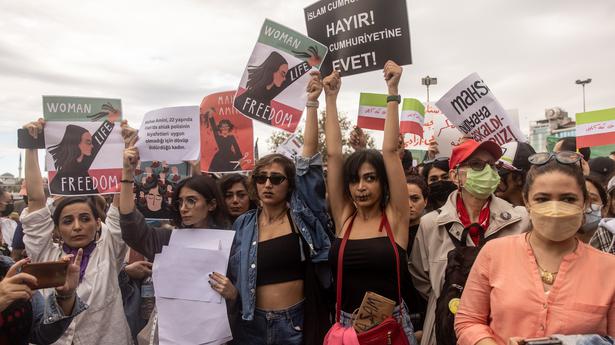
Data | Iran’s performance in key socioeconomic indicators and immediate causes of protests
The Hindu
The lack of adequate political freedoms, the absence of gender equality, and recurrent economic crises have frequently triggered protests
Earlier this month, 22-year-old Mahsa Amini was detained by Iran’s morality police for “violating” the mandatory dress code. Though her family had been assured she would be released after a “re-education session”, she died on September 16 after being rushed to the hospital from the detention centre. Her family has contested the police claim that she died of a heart attack due to underlying conditions. Various reports have claimed that Amini was beaten up by police authorities after which she slipped into coma. Amini’s death has sparked protests across Iran. In the unrest, more than 75 people have so far been killed and hundreds are injured.
Iran has a long history of protests that have been triggered by socioeconomic and political issues. While the 1977-79 uprising unseated the country’s repressive monarchy, the Islamic republic that replaced the Pahlavi dynasty has also been accused of repressing dissent, including by women questioning the imposition of clothing and other behavioural mores by the regime. Here is a look at various protests that have taken place in the country in recent years with data showing the proximate triggers for these.
Chart 1A, 1B and 1C compare how Iranian women fare in literacy rate, labour force participation rate and the share of women in parliament, respectively, compared to women in other countries for whom such data are available. The charts show that though a large section of Iranian women is literate (81%), they have relatively poor economic and political freedom. The current unrest could be a reflection of the social awareness of literate Iranian women and their dismay at their economic situation and lack of political freedoms.
Charts appear incomplete? Click to remove AMP mode
The regime, overshadowed by economic and political crises, has repeatedly witnessed mass protests in the last four decades. The protests in 2017-18 and 2019, which were triggered by price hikes and inflation, reflect this. Chart 1D shows that Iran’s per capita GDP in 2020 was less than $3,000. This placed Iran 148 among 204 countries. Chart 1E displays a poor employment-to-population ratio, which is causing unrest among the youth. These protests have also coincided with the sanctions imposed on Iran by the U.S. in recent years.
Click to subscribe to our Data newsletter
In 2009, over three million demonstrators took to the streets of Tehran protesting against irregularities in the presidential elections. According to Chart 1F, Iran fares poorly in political rights, ranking 157 among 193 countries. Restrictive laws have resulted in people having to fight for their basic rights. Chart 1G shows how civil liberties are poor compared to other countries.

 Run 3 Space | Play Space Running Game
Run 3 Space | Play Space Running Game Traffic Jam 3D | Online Racing Game
Traffic Jam 3D | Online Racing Game Duck Hunt | Play Old Classic Game
Duck Hunt | Play Old Classic Game











